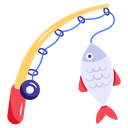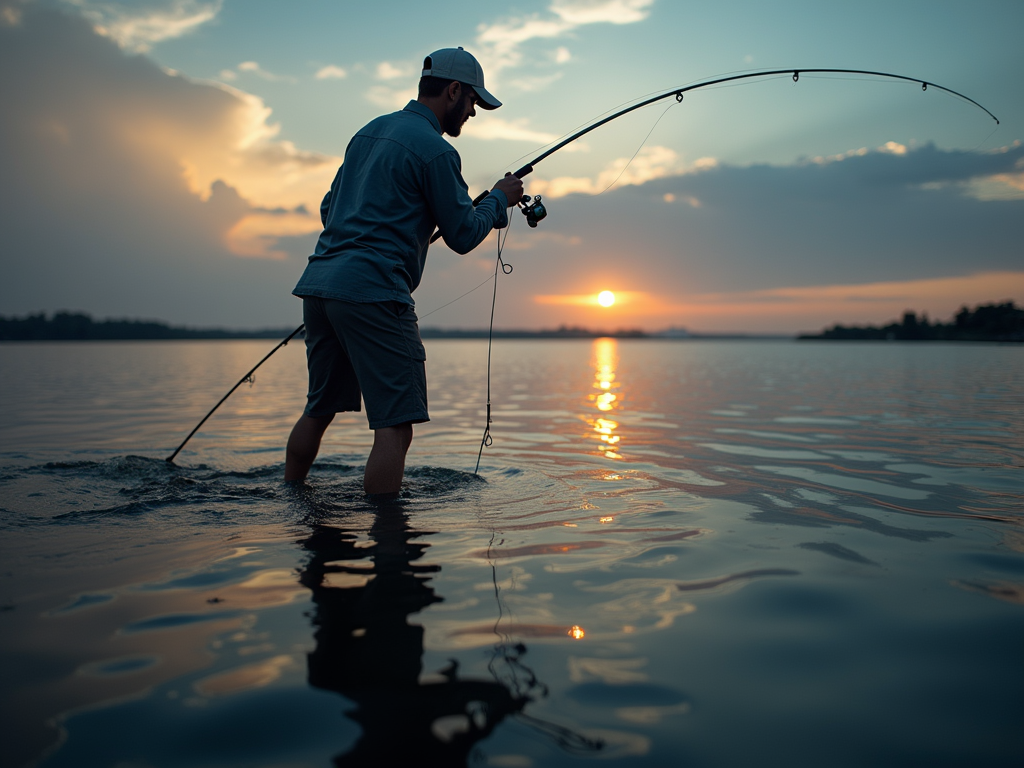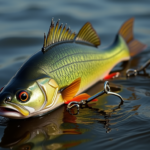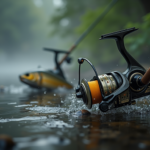Fishing is more than just a pastime; it’s an art that connects anglers with nature and offers a sense of serenity. Central to a successful fishing experience is the right fishing tackle, which includes all the essential tools and equipment necessary for every angler. This ultimate guide to choosing the best fishing tackle will arm you with the knowledge you need to make informed decisions—ensuring your time on the water is both productive and enjoyable. Whether you’re a novice angler just starting or an experienced fisherman looking to refine your gear selection, understanding the nuances of fishing tackle is crucial.
From selecting the perfect fishing rod and reel to decoding various fishing lines and their strengths, this guide will lead you step-by-step through the intricacies of essential lures and baits tailored for every angler. We’ll explore fishing accessories that elevate your game, emphasizing the importance of matching your tackle to your unique fishing style. Whether you’re building your first tackle box or seeking maintenance tips to extend the life of your equipment, we cover all the essential elements you need to enhance your fishing adventure. Dive into this informative resource and ensure you’re fully prepared for your next fishing expedition!
Introduction to Fishing Tackles
Fishing tackle encompasses all the equipment utilized by anglers during their fishing expeditions, making it a critical component for success in the sport. Understanding the different types of fishing tackle, including rods, reels, lines, and bait, allows fishermen to effectively target various species and adapt to diverse fishing conditions. Each element plays a pivotal role in establishing a connection between the angler and the fish, enhancing the overall fishing experience.
Importance of Selecting the Right Fishing Tackle
-
Enhancement of Catch Rates
- The right combination of fishing tackle increases the chances of attracting and hooking fish.
- Specialized tackle can be tailored for specific species, such as:
- Hooks sizes vary by fish type.
- Appropriate line strength matches target species and water conditions.
-
Adaptability to Fishing Environments
- Different fishing environments demand unique tackle adjustments.
- Key factors include:
- Freshwater vs. Saltwater: Requires different tackle setups to withstand corrosion and water conditions.
- Shallow vs. Deep Water: Requires varying weights and bait types to effectively reach fish.
-
Angling Techniques and Strategies
- Knowledge of tackle types informs angling techniques:
- Baitcasting: Useful for precision in casting.
- Fly Fishing: Specialized tackle for enticing fish with artificial flies.
- Successful anglers continually adapt their tackle based on feedback from fishing conditions and fish behavior.
- Knowledge of tackle types informs angling techniques:
Selecting appropriate fishing tackle is more than just a choice; it can make the difference between a successful day on the water and a frustrating one. By understanding the components and their application in various fishing strategies, anglers can enhance their effectiveness and enjoyment in the sport of fishing.
Understanding Different Types of Fishing Tackle
Fishing Rods
Fishing rods are essential tools that come in various lengths, materials, and actions, allowing anglers to target different species and environments.
-
Types of Rods:
- Spinning Rods: Ideal for lightweight lures, perfect for freshwater fishing.
- Baitcasting Rods: Suited for heavier lures, great for bass and saltwater fishing.
- Fly Rods: Specialized for fly fishing, designed for precision casting in rivers and streams.
-
Materials:
- Fiberglass: Durable and flexible, good for beginners.
- Graphite: Lightweight and sensitive, preferred by experienced anglers.
Fishing Reels
Fishing reels are critical for managing line and aiding in the retrieval of fish.
-
Types of Reels:
- Spinning Reels: Easy to use, versatile for various fishing styles and environments.
- Baitcasting Reels: Provide better control for casting heavier lures.
- Fly Reels: Specifically designed for fly fishing, balancing line weight with precision.
-
Reel Features:
- Drag System: Controls the amount of line release when a fish pulls, crucial for fighting larger catches.
- Gear Ratio: Affects the speed at which line is retrieved.
Fishing Lines
Fishing lines connect the angler to the fish and must be chosen based on the fishing technique and surroundings.
- Types of Line:
- Monofilament: Versatile, stretches, making it forgiving for beginners.
- Braided Line: Strong and thin, ideal for heavy cover and big fish.
- Fluorocarbon: Nearly invisible underwater, ideal for clear waters.
Fishing Lures
Lures are artificial baits designed to attract fish, mimicking the movement and appearance of prey.
-
Types of Lures:
- Jigs: Versatile and effective in various water conditions.
- Crankbaits: Good for covering large areas and targeting specific depths.
- Spinnerbaits: Excellent for murky waters, with spinning blades that create vibrations.
-
Lure Materials:
- Plastic: Durable, available in many colors and shapes.
- Metal: Reflective, effective in deeper waters for flash attraction.
Fishing Tackle by Environment
Different types of fishing tackle are more suitable for specific environments, emphasizing the importance of understanding your fishing location.
| Environment | Recommended Rods | Suggested Reels | Ideal Lines | Effective Lures |
|---|---|---|---|---|
| Freshwater Lakes | Spinning, Fly Rods | Spinning, Baitcasting | Monofilament, Fluorocarbon | Jigs, Crankbaits |
| Saltwater Fishing | Baitcasting, Spinning | Baitcasting | Braided, Monofilament | Spinnerbaits, Jigs |
| Rivers and Streams | Fly Rods, Spinning | Spinning | Fluorocarbon, Monofilament | Crankbaits, Streamers |
By selecting the appropriate fishing tackle, anglers can improve their chances of success while enjoying their time on the water.
Selecting the Right Fishing Rod
Understand Your Fishing Style
Choosing the right fishing rod starts with understanding your specific fishing style. Consider the following styles:
- Freshwater Fishing: Opt for lighter rods typically made of graphite or fiberglass for better sensitivity.
- Saltwater Fishing: Look for sturdier rods, often made of corrosion-resistant materials like fiberglass or composite blends.
- Fly Fishing: A lighter, longer rod with a flexible tip is essential for casting flies effectively.
Consider the Species Targeted
Different fish species require different rod specifications. Here’s a quick guide:
| Species | Recommended Rod Action | Rod Power |
|---|---|---|
| Bass | Medium or Medium-Heavy | Fast or Moderate-Fast |
| Trout | Light to Medium | Ultra-Light to Medium |
| Salmon | Medium to Heavy | Moderate to Heavy |
| Carp | Heavy | Moderate to Heavy |
Personal Preferences
Your comfort and preferences play a significant role in selecting the right fishing rod. Keep the following in mind:
- Rod Length: Longer rods (7-9 ft) are generally better for casting distance, while shorter rods (5-6 ft) offer better control.
- Grip Style: Choose between EVA foam or cork grips based on comfort and durability preferences.
- Weight: Make sure the rod is balanced and manageable to avoid fatigue during long fishing sessions.
By aligning your fishing style, target species, and personal preferences, you can confidently choose the fishing rod that will enhance your angling experience.
Choosing the Perfect Fishing Reel
Types of Fishing Reels
Spinning Reels
Spinning reels are among the most popular types used by anglers of all experience levels. Their user-friendly design makes them ideal for beginners while also offering features that appeal to seasoned fishers. Key characteristics include:
- Ease of Use: Simple mechanics that allow for easy casting and retrieval.
- Versatility: Suitable for various fishing styles and environments, from freshwater lakes to saltwater beaches.
- Lightweight Options: They come in a variety of sizes, making them a great choice for light tackle fishing.
Baitcasting Reels
Baitcasting reels are favored by experienced anglers who seek greater accuracy and control in their cast. Their advanced design allows for more precise handling of lures and bait, making them ideal for targeting larger fish. Consider the following when choosing a baitcasting reel:
- Gear Ratio: Higher gear ratios offer faster retrieves, while lower ratios provide more torque for heavier lures.
- Adjustable Brakes: Features like magnetic or centrifugal brakes help minimize backlash and enhance casting performance.
- Weight Capacity: Select a reel that matches your target species, ensuring the capacity can handle heavy lines and baits.
Trolling Reels
Trolling reels are specifically designed for the technique of dragging bait through the water while a boat is in motion. These reels are built to withstand the increased strain of trolling and often have robust features:
- Line Capacity: Look for models that can accommodate larger spools of line to cater to deep trolling.
- Durability: They should be made from corrosion-resistant materials, especially for saltwater conditions.
- Multiple Drag Settings: Good trolling reels typically offer various drag settings to adjust for different fish species and conditions.
Choosing a Reel Based on Experience Level
When selecting the right reel, it’s essential to consider the angler’s experience level and fishing style.
Beginners
- Recommendation: Start with a spinning reel due to its simplicity and versatility.
- Considerations: Look for lightweight, easy-to-manage setups designed for smaller fish.
Intermediate Anglers
- Recommendation: A baitcasting reel can enhance casting accuracy and control.
- Considerations: Focus on reels with adjustable brakes to accommodate skill progression and different fishing scenarios.
Advanced Anglers
- Recommendation: Explore trolling reels for larger game fish, requiring specialized techniques.
- Considerations: Select high-quality reels with appropriate line capacity, robustness, and drag systems that align with targeted fishing locations and species.
By understanding these types of reels and considering the angler’s experience level, it becomes easier to choose the perfect fishing reel that enhances the fishing experience.
Decoding Fishing Lines: Strength and Durability
Types of Fishing Lines
Monofilament Line
- Material: Made from a single strand of nylon.
- Strength: Offers good tensile strength relative to its diameter, making it suitable for various fishing conditions.
- Durability: More susceptible to abrasion and UV damage compared to other types.
- Applications: Best for freshwater fishing and beginners due to its ease of handling.
Fluorocarbon Line
- Material: Composed of polyvinylidene fluoride (PVDF).
- Strength: Similar strength to monofilament but lower diameter visibility in water.
- Durability: More resistant to abrasions and UV light than monofilament.
- Applications: Ideal for clear water conditions or when targeting spooky fish, as it is less visible underwater.
Braided Line
- Material: Made from woven strands of synthetic fiber such as Spectra or Dyneema.
- Strength: Offers superior strength-to-diameter ratio, allowing for lower diameter lines that can handle heavy loads.
- Durability: Excellent abrasion resistance and does not deteriorate from UV exposure.
- Applications: Suitable for deep-sea fishing and in tough conditions where strength and sensitivity are crucial.
Choosing the Best Fishing Line Based on Conditions
| Fishing Condition | Recommended Line Type | Key Considerations |
|---|---|---|
| Freshwater Lakes | Monofilament | Versatile, easy to handle, cost-effective. |
| Clear Water Streams | Fluorocarbon | Low visibility, suitable for wary fish. |
| Weedy Areas | Braided | High strength, minimal stretch for effective pulling. |
| Saltwater Fishing | Braided or Fluorocarbon | Best durability against harsh salt conditions. |
| Heavy Cover Fishing | Braided | Superior strength needed to pull fish from cover. |
| Spooky Fish | Fluorocarbon | Less detectable under clear water. |
Final Considerations
- Test Strength: Ensure to match the line rating to the fishing rod and reel.
- Diameter vs. Strength: Understand that a thinner line may have less visibility but could compromise strength based on the fishing scenario.
- Environmental Factors: Consider water type and clarity, as well as the species of fish targeted, when selecting the best fishing line for your needs.
Essential Lures and Baits for Every Angler
Choosing the Right Baits for Target Fish
Different species of fish require specific baits to trigger their feeding instincts effectively. Understanding the preferences of your target fish is crucial for a successful fishing trip.
Common Fish Species and Their Preferred Baits
| Fish Species | Preferred Baits |
|---|---|
| Bass | Plastic worms, crankbaits, jigs |
| Trout | Live bait (worms, minnows), spinners, spoons |
| Catfish | Stink bait, cut bait, live bait (goldfish) |
| Walleye | Jigs, minnows, trolling crankbaits |
| Panfish | Small jigs, worms, crickets |
Selecting Lures Based on Fishing Environment
The fishing environment plays a significant role in lure effectiveness. Adjusting your lure choice to match conditions such as water type, temperature, and flora can enhance your chances of a successful catch.
Types of Fishing Environments
-
Freshwater Lakes and Ponds
- Use topwater baits early in the morning or late evening.
- For deeper waters, consider using slow-sinking lures or heavy jigs.
-
Rivers and Streams
- Opt for spinners and inline lures that mimic the natural movement of baitfish.
- Adjust your lure weight based on current strength; heavier lures for swift currents.
-
Saltwater Fishing
- Bright, flashy lures often attract species like snapper and mackerel.
- For bottom-dwelling fish, use weighted jigs with natural bait such as squid or shrimp.
By understanding the interplay between targeted fish species and their preferred baits, alongside adapting to varied fishing environments, anglers can optimize their fishing strategies effectively.
Understanding Fishing Accessories: A Comprehensive Guide
The Importance of Fishing Accessories in Your Gear Setup
Fishing accessories play a pivotal role in enhancing your fishing experience by ensuring efficiency and improving your chances of a successful catch. Essential items such as tackle boxes, line clippers, and fish finders provide anglers with the tools they need for organization, convenience, and precision.
Key Fishing Accessories
Tackle Boxes
- Organization: Tackle boxes are crucial for keeping your fishing gear organized. They typically feature multiple compartments for various accessories such as lures, hooks, sinkers, and more.
- Protection: A good tackle box will protect your bait and tackle from environmental factors like moisture, which can compromise their effectiveness.
- Types:
- Hard Tackle Boxes: Durable, providing excellent protection.
- Soft Tackle Bags: Lightweight and flexible, ideal for carrying a range of items.
Line Clippers
- Functionality: Line clippers are essential for quickly and efficiently cutting fishing line when necessary. They help in making precise cuts, which are crucial during setups and when switching lures.
- Variety: Available in different styles, including:
- Standard Clippers: Basic, easy to use.
- Ergonomic Models: Designed for comfort during extended use.
Fish Finders
- Technology Integration: Modern fish finders utilize sonar technology to detect fish underwater, giving anglers a distinct advantage in locating their targets.
- Features to Consider:
- Display Size: Larger screens offer better visibility and easier navigation.
- GPS Capabilities: Integrated GPS can help you mark fishing hotspots and navigate to them efficiently.
- Depth Range: Ensure your fish finder has a suitable depth range for your fishing locations.
Relevance in a Successful Fishing Trip
- Efficiency: The right fishing accessories streamline the process of setting up and reeling in catches, making your fishing trip more productive.
- Preparation: Being well-equipped with the essential tools minimizes downtime and maximizes your time spent actively fishing, ultimately leading to a more enjoyable and fruitful experience.
The Importance of Matching Tackle to Fishing Style
Different Fishing Styles and Their Tackle Needs
Fly Fishing
Fly fishing is characterized by its unique casting technique, where an artificial fly is used to attract fish. The tackle selection for fly fishing is crucial:
- Rod: Light to medium action rods are preferred for better casting control.
- Reel: A lightweight reel designed for quick line retrieval ensures efficiency.
- Line: Specialty fly lines, such as floating or sinking lines, cater to diverse water conditions and fish behaviors.
Ice Fishing
Ice fishing requires specific tackle adaptations due to cold conditions and restricted access to fish:
- Rod: Shorter, more sensitive rods allow for quick detection of bites.
- Reel: Inline reels or simple spinning reels provide ease of use in confined spaces.
- Bait and Lures: Jigs and live bait are essential for attracting fish under ice, often enhanced with electronic fish finders.
Surf Casting
Surf casting involves fishing from the shore into ocean waters, necessitating robust tackle:
- Rod: Long rods (9-14 feet) enable increased casting distance over waves.
- Reel: Heavy-duty spinning or conventional reels can manage strong currents and larger fish.
- Line and Bait: Braided lines for strength and larger baits like cut bait or lures to attract species like striped bass or bluefish are commonly used.
Comparison of Tackle Selection across Fishing Styles
| Fishing Style | Rod Type | Reel Type | Line Type | Bait/Lures |
|---|---|---|---|---|
| Fly Fishing | Light to medium | Lightweight fly reel | Specialty fly line | Artificial flies |
| Ice Fishing | Short, sensitive | Inline or spinning reel | Monofilament/Fluorocarbon | Jigs and live bait |
| Surf Casting | 9-14 feet long | Heavy-duty spinning/conventional | Braided line | Larger baits and lures |
Understanding how different fishing styles dictate tackle choices is essential for anglers. By aligning specific tackle to their preferred fishing method, anglers can enhance their effectiveness on the water, improve their catch rates, and ultimately enjoy a more fulfilling fishing experience.
Tips for Beginners: Building Your First Tackle Box
Essential Items for Your Tackle Box
To ensure you’re prepared for a range of fishing scenarios, consider including the following essential items in your tackle box:
-
Fishing Rod and Reel
- Choose a lightweight rod that is easy to handle.
- A spinning reel or baitcasting reel depending on personal preference.
-
Fishing Line
- Monofilament line is recommended for beginners due to its ease of use.
- Consider a strength range of 6-12 lb test for versatility.
-
Hooks
- A variety of hooks from size #6 to #1/0 for different bait types.
- Include both treble and single hooks for various fishing techniques.
-
Baits and Lures
- Live bait such as worms or minnows for natural fish attraction.
- A selection of hard and soft plastic lures to mimic local forage.
-
Weights and Sinkers
- Include a range of split shots and bullet weights to accommodate different depths.
- Crimp-on weights for easy adjustments.
Additional Accessories for Optimal Fishing
Ensure your tackle box is comprehensive by including these accessories:
-
Bobbers and Floatation Devices
- Slip bobbers for presenting bait at various depths.
- Fixed bobbers for holding live bait near the surface.
-
Pliers and Line Cutters
- Needle-nose pliers for hook removal and line cutting.
- Line snips for clean cuts on fishing line.
-
Fishing License and Regulations
- Don’t forget to include your fishing license and any specific local fishing regulations.
-
First Aid Kit
- Basic first aid supplies for minor injuries while out on the water.
Organizing Your Tackle Box
To keep your tackle box efficient and user-friendly, follow these organization tips:
| Category | Suggested Organization |
|---|---|
| Baits & Lures | Use small containers or trays. |
| Hooks | Store in a dedicated compartment. |
| Weights | Keep separate to avoid tangling. |
| Tools | Designate a clear section for tools. |
- Label compartments for easy access to items.
- Check gear regularly to ensure you have a full setup for every fishing trip.
Maintaining Your Fishing Tackle: Tips for Longevity
Regular Cleaning
Keeping your fishing tackle clean is essential for its longevity. After each fishing trip, make it a habit to rinse off your gear with freshwater to remove any salt, sand, or dirt that may have accumulated. This simple step helps prevent corrosion, especially on reels, hooks, and other metallic parts.
- Recommended Cleaning Supplies:
- Mild soap
- Soft cloth or sponge
- Freshwater source
Proper Storage
Storing your fishing tackle properly is crucial to maintaining its effectiveness. Use tackle boxes or bags that provide adequate protection against moisture and physical damage.
- Storage Tips:
- Keep your tackle in a cool, dry place.
- Use dividers in tackle boxes to prevent hooks and lures from tangling.
- Store rods horizontally to avoid warping.
Routine Inspections
Conducting regular inspections of your fishing tackle can help catch issues before they become significant problems. Check your lines for fraying, inspect reels for smooth operation, and ensure hooks are sharp and free from rust.
- Inspection Checklist:
- Lines: Look for knots or damage
- Reels: Test drag and retrieve
- Hooks: Sharpen or replace if needed
Maintenance of Specific Items
Certain items in your fishing tackle deserve extra attention to ensure longevity and effectiveness.
- Reels: Apply a few drops of oil to moving parts and clean the spool.
- Rods: Inspect guides and check for any signs of wear.
- Lures: Regularly check for loose components or paint chips.
By adhering to these maintenance tips, anglers can significantly extend the lifespan of their fishing tackle, ensuring that their equipment remains in top condition for successful fishing trips.
Conclusion: Elevate Your Fishing Experience with the Right Tackle
In this ultimate guide to choosing the best fishing tackle for every angler, we’ve explored key components that can significantly enhance your fishing adventures. By understanding the basics of fishing tackle—ranging from fishing rods and reels to lines, lures, and essential accessories—you’ll be well-equipped to make informed choices tailored to your specific angling style and environment. Remember, selecting the right fishing rod and reel matched with the appropriate fishing line strength and durability is essential to increasing your catch rates and improving your overall experience on the water.
Moreover, we’ve delved into the importance of adapting your tackle to different environments and fish species and provided actionable tips for beginners looking to build their first tackle box. Maintaining your fishing gear regularly ensures its longevity and effectiveness, allowing you to enjoy countless fishing trips ahead. So whether you are just starting out or looking to refine your tackle setup, take these insights and get out on the water, ready to reel in your next big catch! Embrace the joy of fishing with the right tackle—your next adventure awaits!




